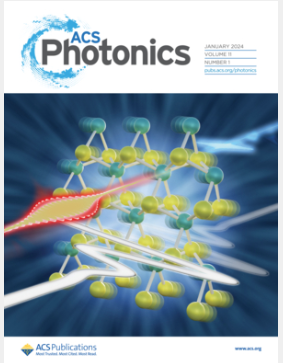High-Quality Microfluidic Lasers from Water-Soluble Semiconductor Quantum Dots with Auspicious Optical Gain
IF 6.5
1区 物理与天体物理
Q1 MATERIALS SCIENCE, MULTIDISCIPLINARY
引用次数: 0
Abstract
Water-soluble quantum-dot (w-QD) lasing is crucial for the emerging fields of optofluidics, biophotonics, and diagnostics. However, the existing w-QDs are not competent due to their inferior optical gain and poor photostability. Herein, a hydrophilic ligand screening criterion is established to find suitable candidates for developing w-QD lasers. The comprehensive spectroscopic characterizations reveal that the thioglycolic acid-capped w-QDs exhibit superior gain performance that is on par with those of state-of-the-art nonpolar QDs, including the long gain lifetime, large gain cross-section, and low threshold of amplified spontaneous emission. The mechanistic study based on transient absorption and first-principles calculation discloses that the auspicious gain is enabled by the large surface binding energy, small absolute redox potential, and exceptional dispersibility of the w-QDs. On this basis, a novel high-quality microfluidic laser is constructed from the w-QDs, exhibiting a low threshold, high Q-factor, and long-term robustness. The findings represent a significant step toward w-QD lasers and may unlock new possibilities for advanced optofluidics and medical imaging.

具有吉祥光学增益的水溶性半导体量子点制备的高品质微流控激光器
水溶性量子点(w-QD)激光对于光流体学、生物光子学和诊断学等新兴领域至关重要。然而,现有的w- qd由于其较低的光学增益和光稳定性差而无法胜任。本文建立了一种亲水配体筛选标准,以寻找适合发展w-QD激光器的候选配体。综合光谱表征表明,巯基乙酸包封的w-QDs具有较长的增益寿命、较大的增益截面和较低的放大自发发射阈值,其增益性能与目前最先进的非极性QDs相当。基于瞬态吸收和第一性原理计算的机理研究表明,w-QDs具有大的表面结合能、小的绝对氧化还原电位和优异的分散性,从而实现了良好的增益。在此基础上,利用w-量子点构建了具有低阈值、高q因子和长期鲁棒性的新型高质量微流体激光器。这一发现代表了向w-QD激光器迈出的重要一步,并可能为先进的光流体和医学成像开辟新的可能性。
本文章由计算机程序翻译,如有差异,请以英文原文为准。
求助全文
约1分钟内获得全文
求助全文
来源期刊

ACS Photonics
NANOSCIENCE & NANOTECHNOLOGY-MATERIALS SCIENCE, MULTIDISCIPLINARY
CiteScore
11.90
自引率
5.70%
发文量
438
审稿时长
2.3 months
期刊介绍:
Published as soon as accepted and summarized in monthly issues, ACS Photonics will publish Research Articles, Letters, Perspectives, and Reviews, to encompass the full scope of published research in this field.
 求助内容:
求助内容: 应助结果提醒方式:
应助结果提醒方式:


